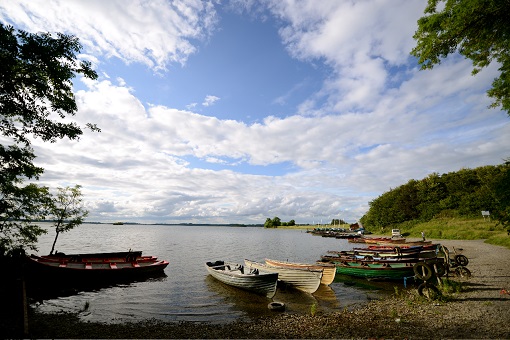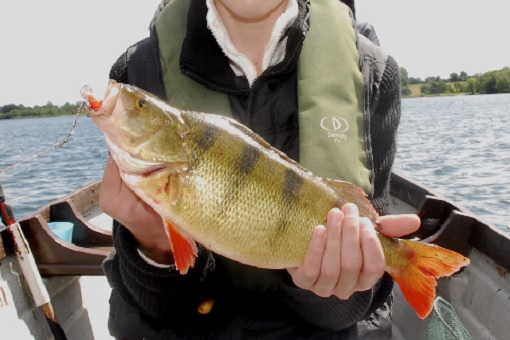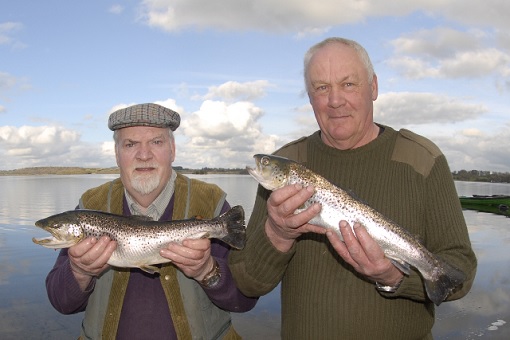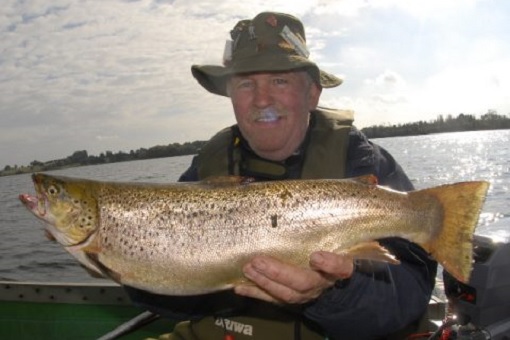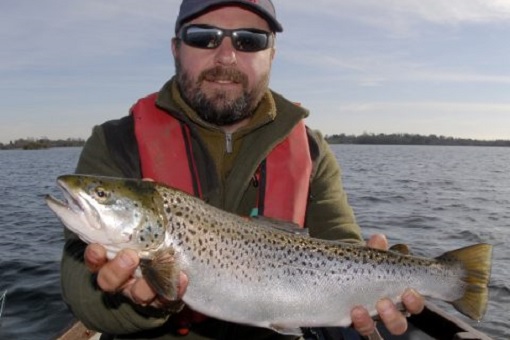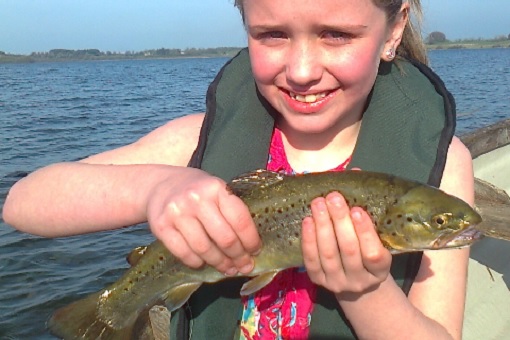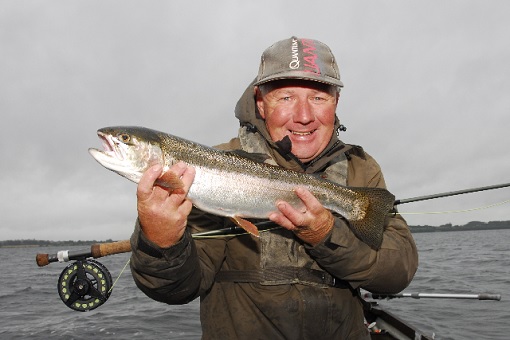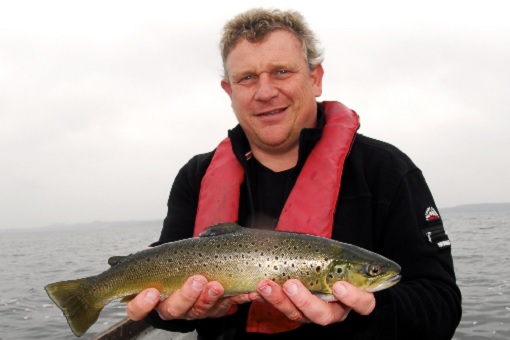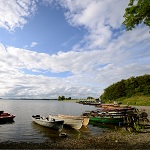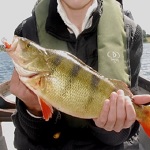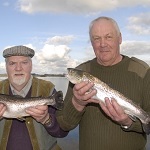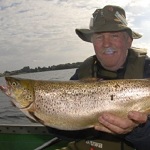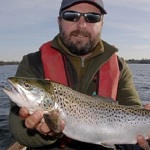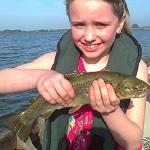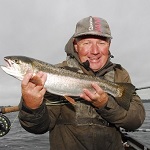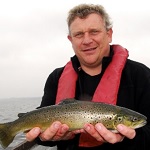Introduction
Owel is a deep lake with less fishing shallows than other Midland Lakes, but fishing can be productive, even over deep water. With the exceptional water clarity and with flies drifting out from the shore it often pays to drift well beyond the shallows, indeed right across the lake in some instances.It has a high pH, mainly spring fed limestone lake with an area of 2547 acres ( over 1000 Hectares ). It has remarkable water quality and can give visibility to a depth of over 20 feet (6m) on a bright day.
The lake has a resident stock of wild brown trout, with an average weight of about 2lbs. In Lough Owel spawning and nursery facilities for Brown Trout are extremely limited. The lake which for the most part is spring fed, has few tributaries, all of which are small. If all the native trout were allowed to run the streams each year there would be considerable losses because the available spawning grounds would be fully utilised by the first runs of fish. Their redds would be distributed by a succeeding runs of fish and consequently the ova would be lost. To prevent such wastage a policy operates which allows the available gravel in streams to be fully used for spawning. Surplus ova, which would otherwise be wasted, are then stripped from the runs of native adult trout which subsequently enter the streams. These ova are hatched out at the nearby Cullion Fish Farm and large numbers of the resulting fry and adult fish are later stocked back into the lake. They thrive and grow quickly on a rich diet, eliminating the necessity for any staggered stocking programme. In this way, Lough Owel is maintained as a high class trout fishery.
The average size of the trout is remarkably large - averaging about 2lbs. Trout to about 7lbs are taken every season by anglers and fishery staff have encountered fish up to 11 - 12lbs in the streams at spawning time.
Early Season
The season opens in March and during this month and into early April, the best method of taking trout is by trolling. The trout prey heavily on sticklebacks and local advise is to fish a 1.5 inch grey Lane Minnow. Imitative lures fished on sunk lines would probably be equally effective. The areas to concentrate on are close in by the shore and over and around known shallows. There is little opportunity for bank fishing on Owel and anglers should note that there is no fishing along the railway wall - CIE has fines in place for persons found to be walking the railway line.
The first hatches of Duckfly occur around the second or third week of April and the hatch lasts for approximately two weeks. The best hatches are to the west of Studorra Island in the ‘neck’ of the lake from Mount Murray across to Kilpatrick Point. Little fishing is done at this time as conditions have to be suitable - mild evenings being desirable - before the trout take the fly.The most commonly used wet flies at this time are Connemara Black, Black Pennell, Claret and Mallard, Sooty Olive and Duckfly imitations.
May - June
The fly fishing really peaks around May 15th and often remains lively until mid June, with hatches of Lake Olives, Buzzers and even occasion Mayfly. The fishing can be fair to good during the day with some really excellent evening response to buzzer, particularly towards the end of May. The more popular flies are Sooty Olive, Bibio, Greenwells Glory, Cock Robin, Claret and Mallard, Green Olive, Gosling Mayfly, Grey Duster and various Buzzer pupa imitations. The late evening and night time buzzer fishing can be best of all, and it is worth noting that the Grey Duster fished dry will take more fish than any other fly when cast to a feeding trout. This pattern should be dressed with a good quality badger cock hackle, the tips of which must be white and not cream or grey.
Some anglers like to fish from morning until evening, finishing around 7 p.m. This can be very convenient, but often not very successful. The angler going out at 7pm and leaving the water at 11.30pm or midnight generally gets much better results and more action. More fish can often be caught in the last hours of daylight than earlier in the day as there are more insects on the water. On the warmer evenings flies such as Reed Smuts, stone flies and cockybondhu beetles can induce a frenzied feeding spell. Useful patterns at this time of year are Golden Olive or an Orange and Grouse dressed on a size 12 or 14 hook and will take trout feeding on a stonefly in a ripple. Fish feeding on Reed Smuts can provide superb sport, especially to the dry enthusiast who must be prepared to fish small black dry flies. A Black Gnat size 14 or 16 on fine tackle will prove productive. The best fishing will always be obtained in calm water along by the shore and especially along by reed beds or bog lands. The bay known as ‘Bog Lake’ and the area to the west of Sruddorra Island can be particularly good for this type of fishing. In very calm and mild conditions fish feeding on smut will take a small Bibio size 12 or 14 or a Black Pennell.
High Season (July - August)
There is generally a lull in the trout fishing season from about the second week of June until the third week in July and few anglers fish the lake during this time. Instead they will be waiting for the annual hatch of large sedge - Pyryganea species - known in Ireland as the Green Peter. It is difficult to give an exact time of year for the emergence of this fly. During a hot summer, the hatch can begin as early as July 14th, while in a cooler season it may be delayed by a couple of extra weeks. The hatch starts about 10pm and lasts for about one hour and may go on much longer. It is vital to remember that the best fishing is always after dark on Lough Owel. Another point worth noting is that the first week or ten days of the hatch is always provides the best fishing. The trout feed more avidly early on in the cycle but after about two weeks fishing begins to slow down. These great sedges hatch in open water. The most important areas of the lake for this particular fly are from Sruddorra Island to Portloman and along by the Cornfield shore. On the east side , the hatch occurs around Church Island and along by the shallows off the Bull Ring. The Green Peter brings up the best fish in the Lough. During the Green Peter hatch trout angling is at its best and trout are caught in quite large numbers. This is the period that nearly always produces the biggest trout of the season.
Your best course of action would be to fish a team of wetflies in the areas mentioned above until about 10pm. A Green Peter on the bob, an Invicta in the middle and a Green Peter pupa on the point will do just fine. When the first fish appear at the surface, they take the adult fly as they scuttle across the surface - this is time for fishing the dry fly. Cast it in the path of a feeding fish and tweak it slowly along the surface. When the fish takes, avoid striking immediately to allow the fish to turn down before sending the hook home.
End of Season
There can be an excellent day time fishing to wetflies through mid August, September and even early October. Fish anywhere, even out into deep water. In warm weather you should pay special attention to the area along by the small pump house on the east shore. There are lots of cool springs in this area and the trout tend to congregate here. There can be very good wetfly fishing during late evenings in August to a mixture of buzzers, small sedge hatches and small black terrestrial flies. The best Autumn fishing is in September, particularily when strong north - westerly or south easterly winds sweep across the length of the lake. Such winds do not suit Loughs Ennell or Sheelin but are ideal on Owel.
Dapping
Dapping can work wonderfully well on Owel from late July through August and September and even into October. Without doubt the favourite ‘dap’ on Owel is the Grasshopper. This land based insect is rarely found on the water, but for some unknown reason it can be very productive. Local anglers consider it to be far more superior to the ‘Daddy’ Unlike dapping a mayfly only on insect is used, attached to a size 8 or 10 hook. For those who have difficulty getting in obtaining grasshoppers or who run short of supply during a days fishing can usually replenish by collecting them along the shore in front of the trees at Captains Hill or along the shore at Portloman. They are best sought out on a bright warm day and should be stored in a dry, airy box containing dry grass or new mown hay
Let us summarise the fly hatch on Lough Owel by saying that it has a good hatch of Duckfly in spring and a good Green peter hatch in July and August, and fair hatches of Olives in May and again in late August - September. The Mayfly hatch can be best described as sparse and localised.
The native Lough Owel trout are dour except during the evening Buzzer hatch in May and the Green Peter hatch in July and August, The fish can also be fairly active in September during the day.
The stocked trout, already mentioned, make a considerable contribution to the liveliness of the fishing on the Lough in September.
Factilities and Access
There is good public access and boat berthage at Tullaghan on the southern shore of the lake. Access is signposted from the Old Longford Road the N4. Nearest town Mullingar (2.5 miles), Nearest Village - Multifarnham (4 miles). There is public access to the lake at Mullally's on the southern end of the lake just off the main old Mullingar - Longford Road. This comprises of a car park and green park area and is a safe mooring area for angling boats. Hire boats are moored in this area also.
Lough Owel lies 2.5 miles ( 4km ) north west of Mullingar, to the left of the Mullingar - Longford road.
